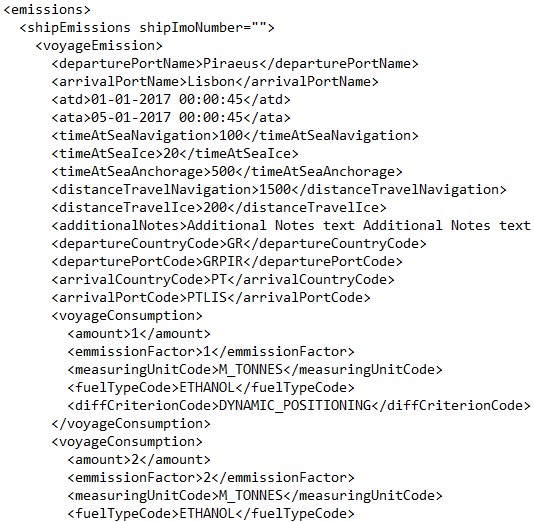The 2019 MRV Requests
With the end of 2018 arrive new important deadlines for the shipping activity. During this present year ship owners had the obligation of monitoring data from vessel’s activity, being the most important the monitoring fuel consumed and the tonnes of CO2 emitted.
With EU MRV, companies had the necessity of having a Monitoring Plan updated and assessed by accredited verifiers and also to keep on board a Document of Compliance (DOC). This regulation represented a lot of concerns to the shipping companies namely in order to avoid non-conformities and non-compliance with IMO commitments.
New year… New commitments
With the arrival of 2019, new responsibilities come along. After 2018 data collection, ship owners must report to European Commission and Flag State the emissions of each of their vessels. EMSA has developed a new module in THETIS, the THETIS-MRV, enabling companies to report their CO2 emissions.
Through this platform, all relevant parties foreseen by the Regulation can fulfil their monitoring and reporting obligations in a centralized and harmonised way. During 2018, in THETIS-MRV, company members must upload an XML ou XSD file correspondent to each vessel, in alternative to manual input.


Fig. 1 – Information to be reported in THETIS-MRV Platform
In the “Emissions” file (Fig. 1) the company can place values related to Voyage Emissions and Port Emissions. If the company can’t generate this file it can be filled manually. Either way, in the platform, the user must go the initial page, click in a specific vessel, and choose “Actions ->Edit”. In the separators “Monitor on a per-voyage basis” and “Monitor on a port activity basis” the voyage data can be added. The platform will do the calculations and generate the annual aggregated basis of the data monitored.
o enhance the process for companies with more than one vessel, it is possible to upload an XML ou XSD file for all the fleet. To do so in “My Fleet” page the user must select “upload data in bulk”. By choosing this option the company can upload CO2 emissions (a file that combines voyage and port emissions), Emission Reports or even Monitoring Plans. This information will be gathered within a file for all vessels in a coded language (Fig. 2). Data for each vessel is added sequentially.
In 2019, companies will be obliged to create an Emissions Report to be submitted in this platform, which has to be verified until 30th April 2019 by recognized independent verifiers. By fulfilling this commitment, and once it is recognized that the vessel complies with EU 757/2015, the verifier issues a DOC which has to be carried on board (from 30th June 2019 on) for the activities of the succeeding calendar year.
The DOC (valid for a period of 18 months after the end of the reporting period) shall include the following information:
- The identity of the ship (name, IMO identification number and port of registry or home port);
- Name, address and principal place of business of the shipowner;
- The identity of the verifier;
- Date of issue of the document of compliance, its period of validity and the reporting period it refers to.

Fig. 2 – XML file for Emissions communication – an example of Emissions file for a certain fleet.
TecnoVeritas, as a recognized MRV independent verifier by EMSA, has followed how their clients are dealing with MRV. It has been noticed a big commitment towards this new Regulation, which was proven by the presentation of Monitoring Plans of each vessel in compliance and current collection of data during this monitoring period. Companies are even updating their IT system to enhance the data reporting to the THETIS-MRV Platform.
Although this might be seen as a success case, by mid-2018, according to press-released surveys, some companies had not yet validated the Monitoring Plans, and others were not even aware of what MRV system is, nor preparing for it.
Does the implementation of IMO-DCS mean the end of EU MRV?
Shipping companies are adapting to this set of rules. However, in 2019, worldwide legislation comes into force a: IMO-DCS.
This new framework is to enter in force in January 2019 and is applied to vessels with more than 5000 GT that enter any port of call (not only EU Port). Both EU MRV and IMO DCS requirements are mandatory and intend to be the first step in a process to collect and analyse emission data related to the shipping industry. Whilst the EU scheme has focused on CO2 emissions from shipping activities too, from and within the EU area, the IMO scheme covers emissions from shipping at a global scale. Whether, how and when the two regimes will converge is not yet decided, although it is expected that both EU MRV and IMO-DCS work in parallel at least in the next few years.
In summary
In general, these are the following deadlines for 2019:
- 1st January | IMO-DCS | Beginning of the first reporting period.
- 30th April | MRV | Submission of verified Emissions Report to EC and Flag State.
- 30th June | MRV | Issuance of the DOC to be retained on board.
- 31st December | IMO-DCS | End of the first reporting period.



